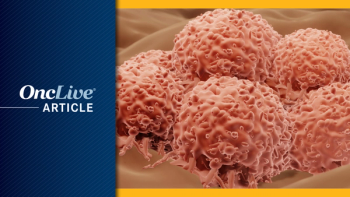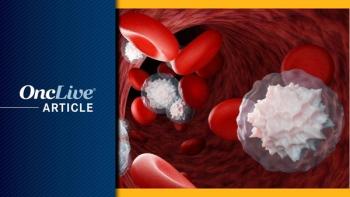
Seribantumab Induces Tumor Regression in NRG1 Fusion+ GI Cancer Mouse Models
Seribantumab demonstrated efficacy in reducing tumor growth in preclinical models of NRG1 fusion–positive gastrointestinal cancers, suggesting that the use of seribantumab as monotherapy could have clinical utility in treating patients with GI and other NRG1 fusion–driven cancers.
Seribantumab demonstrated efficacy in reducing tumor growth in preclinical models of NRG1 fusion–positive gastrointestinal (GI) cancers, suggesting that the use of seribantumab as monotherapy could have clinical utility in treating patients with GI and other NRG1 fusion–driven cancers, according to data presented during Week 1 of the virtual AACR Annual Meeting 2021.1
The results showed that inhibition of tumor growth was achieved after administration of 5 or 10 mg of twice weekly seribantumab in a patient-derived xenograft (PDX) mouse model of APP-NRG1 rearrangement–positive pancreatic adenocarcinoma.
Moreover, seribantumab outperformed the pan-ERBB inhibitor afatinib (Gilotrif), given at 5 mg/kg daily, in terms of tumor shrinkage. Seribantumab induced tumor shrinkage of up to 55% (range, 23%-77%), whereas afatinib-treated PDX models of pancreatic adenocarcinoma did not show any tumor regression.
“These data support the use of seribantumab [monotherapy] to treat GI and other cancers uniquely driven by an NRG1 fusion in the ongoing phase 2 CRESTONE study [NCT04383210],” lead study author Igor Odintsov, MD, research fellow at Memorial Sloan Kettering Cancer Center, and colleagues, wrote in the poster on the data.
The CRESTONE study will treat approximately 75 adult patients with recurrent, locally advanced, or metastatic solid tumors that have progressed or have been nonresponsive to available therapies with seribantumab.2 Tumor types to be studied include cancers of the pancreas, lung, head and neck, breast, kidney, bladder, gallbladder, bile duct, and prostate, colorectal, ovarian, esophageal, and uterine cancers, sarcomas, and cholangiocarcinoma.
Overall response rate will serve as the primary end point of the study with duration of response, safety, progression-free survival, overall survival, and clinical benefit rate as key secondary end points. Additionally, the clinical relevance of NRG1 fusion partners, impact of prior therapies, and resistance mechanisms will be evaluated in exploratory analyses.
NRG1 fusions are rare alterations present in approximately 0.2% of all solid tumors, including lung, breast, and GI cancers.1 GI cancers, such as pancreatic adenocarcinoma and cholangiocarcinoma, account for about 20% of NRG1 fusion–positive solid tumors. Currently, no therapies are approved to treat patients with this subtype of cancers.
In this analysis, investigators evaluated the efficacy of the anti-HER3 monoclonal antibody seribantumab in preclinical models of NRG1-driven GI cancers. Models of isogenic NRG1 fusion–positive pancreatic cancer cells were developed by lentiviral-mediated complementary DNA expression of ATP1B1-NRG1 and SLC3A2-NRG1 fusions in H6C7 cells.
Isogenic cell lines and PDX models of pancreatic adenocarcinoma and intrahepatic cholangiocarcinoma were used to evaluate the preclinical efficacy of seribantumab. Between 5 and 8 mice were treated with the indicated agents per group.
Western blotting was used to analyze protein phosphorylation and expression. Finally, reverse transcription polymerase chain reaction and next-generation sequencing were used to confirm the presence of NRG1 fusions in the models.
Additional results showed that expression of NRG1 fusions in H6C7 cells yielded enhanced phosphorylation of HER3 and AKT vs empty vector control cells. Dose-dependent inhibition of HER3 and AKT phosphorylation was confirmed with seribantumab treatment in H6C7-ATP1B1-NRG1 and H6C7-SLC3A2-NRG1 pancreatic cells.
Furthermore, residual APP-NRG1 rearrangement–positive pancreatic adenocarcinoma tumors were extracted for Western blotting analysis after treatment on day 24 for vehicle, day 31 for seribantumab, and day 32 for afatinib.
The results suggested that the majority of human tumor cells in the xenograft tumors were lost after seribantumab treatment, indicated by loss of phosphorylation and total EGFR, HER2/HER3, cyclin D1, and other proteins. A human-specific GAPDH antibody confirmed these findings.
Additionally, investigators further analyzed the efficacy of seribantumab in a PDX model of intrahepatic cholangiocarcinoma that harbored an RPBMS-NRG1 fusion, ERBB4 mutation, and IDH1 mutation.
The analysis of this model showed that seribantumab, dosed at 5 mg and 10 mg twice weekly, was equally effective compared with afatinib, dosed at 5 mg/kg daily. However, enhanced tumor regression was observed with combination therapy. Twice weekly seribantumab at 10 mg plus afatinib and the IDH inhibitor AG-120 demonstrated tumor regressions in the majority of tumors evaluated.
“Investigation of a cholangiocarcinoma PDX model with 3 genomic alterations—NRG1 fusion and ERBB4 and IDH1 mutations—suggests that treatment of NRG1 fusion–driven tumors harboring additional oncogenic drivers may require combination therapy to address the contribution of each genomic alteration in disease progression,” wrote Odintsov and co-authors.
Notably, allometric scaling per FDA guidelines indicated that 5 mg/kg of afatinib in mice is equivalent to approximately 50 mg daily in humans.
References
- Odintsov I, Kurth RI, Lui AJW, et al. Preclinical activity of seribantumab in gastrointestinal cancers with NRG1 fusions. Presented at: AACR Annual Meeting 2021; April 10-15, 2021; Virtual. Abstract 935.
- Study of seribantumab in adult patients with NRG1 gene fusion positive advanced solid tumors. ClinicalTrials.gov. Posted May 12, 2020. Updated April 6, 2021. Accessed April 9, 2021.
https://www.clinicaltrials.gov/ct2/show/NCT04383210?term=seribantumab&draw=2

























































































